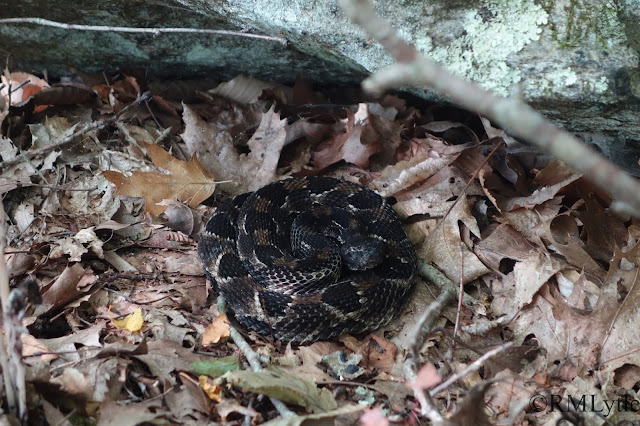I've visited a location that harbors timbers through late spring and summer on and off for a number years now. But making friends with another herper I incidentally met there this year encouraged me to broaden my scope and learn that area and others better. Frankly in recent years my only concerted efforts to see snakes had been brief visits to this one ledge a couple times a year. More often than not, if I found any other snakes it was while fishing or if I spotted a nice piece of plywood begging to be lifted on the way to or from fishing. My herping was pretty limited to that and going out on rainy spring nights to observe the movements of frogs and salamanders on their annual migration to breeding sites. But the kid that couldn't pass a rotted log without rolling it has awakened in me again. I've had a desire to see, catch, and photograph snakes more in the last couple months than I have in years. I'd never lost the love, I just got distracted. But now I'm back and I'm more excited than ever. And this fall has already provided my with phenomenal opportunities to see and photograph timber rattlesnakes. I've seen more timber rattlesnakes in the last couple weeks than I had seen in the last six years combined, and really I haven't even hit the conditions just right yet. And I will. But what I've got now is pretty good.
When I spotted my first neonate, I was blown away. It was perfect in every way, seemingly innocent and benign, and truly imperiled by the very world it had been born into, and yet simultaneously bearing a potent venom that would make them very dangerous... if they weren't remarkably docile and reclusive animals. Bites are nearly always a result of handling. I won't handle a venomous snake unless the uncommon circumstance where one needs to be moved for its own safety or the safety of others arises. But I am comfortable getting within range of some timbers. This neonate wanted me to think he was a rock or a leaf or a bit of bark. He wasn't going to move and blow his cover.
Adult female timbers live birth typically about 10 already quite large babies. Some are big enough to eat mice even before their first shed. Birthing takes a lot out of the females. They need to take a log break before they birth again, if they even survive the ordeal at all. Two of the females I saw being followed by neonates back to the den were in pretty rough shape.
With cooler weather here, my time to observe these animals year this is limited but also the best little window there is.
I'll leave you with a simple message. We are lucky to still have some of these snakes in CT. Very, very lucky. Respect them. Protect them. Poachers, development, and persecution threaten CT's native snakes. Ending all three is an uphill battle, but I , for one, will never stop fighting it.
Until next time.
Fish for the love of fish.
Fish for the love of places fish live.
Fish for you.
Thank you to my Patrons; Erin, David, john, Elizabeth, and Christopher, for supporting this blog.














Your adventures always amaze me! I haven't seen one for a while, but I'm sure they have seen me. Great photos of them. Yes we do have to preserve them.
ReplyDeleteTie, fish, write, conserve and photo on...
Thank you.
DeleteLove these shots man!
ReplyDeleteThank you!
DeleteWonderful photos of the timber rattlers, RM. Like you, I am glad to see that some are still around.
ReplyDeleteThank you!
DeleteSimply extraordinary.
ReplyDeleteThank you.
DeleteGreat stuff....thanks!
ReplyDeleteThank you!
Delete